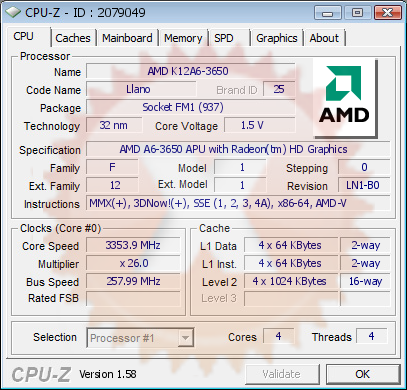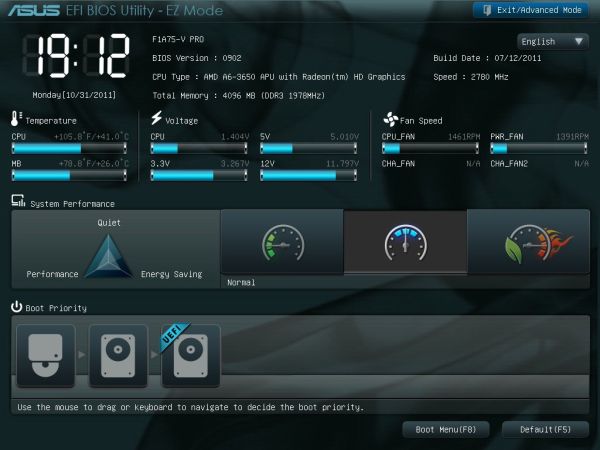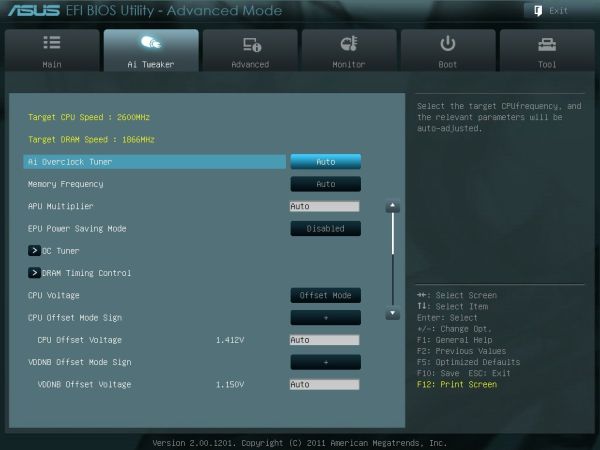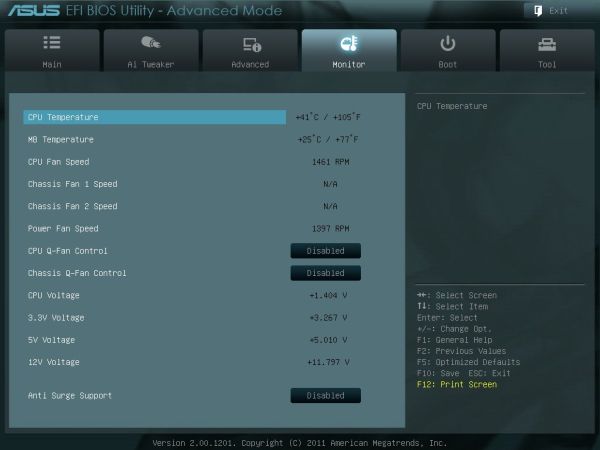ASUS F1A75-V Pro vs. Gigabyte GA-A75-UD4H – Llano at ~$120
by Ian Cutress on November 7, 2011 6:00 AM EST- Posted in
- Motherboards
- Gigabyte
- Asus
- A75
BIOS
ASUS’ BIOS is pretty ingrained into the psyche of motherboard reviewers—it has not changed much since the beginning of the year and it is on every new ASUS motherboard product. I did not find any issues in the BIOS particularly—perhaps a few more features could be added, but nothing provided any issues.
The front screen is what we want from every manufacturer—an easy to use mode which states all the information I want to see on the board. We can see the motherboard model and BIOS version, the CPU being used, memory, memory speed, fan speeds, voltages, temperatures, a quick select for power saving or performance modes, and a quick boot priority select. If I were to change anything on this, I would have a quick one-button press to the advanced mode, and I would want to double click something on the boot order to instantly boot from that device. Perhaps for future versions!
Inside the advanced mode is also the standard ASUS fare. Overclock options are available in terms of manual CPU adjustment, or DOCP—a kind of memory auto overclock feature which adjusts the CPU to meet memory conditions. DRAM timings are as we would expect, and voltage modifications can be done in terms of an offset or an absolute value. The ASUS BIOS team has heard various user requirements for adjustments and has taken them on board.
The Digi+ VRM options might confuse people who have not ever read one of ASUS’ overclocking guides. The guide usually states that to get the best overclock, these options should be put to the max potential—these are adjustable in the OS with AI Suite, which offers pictures and a better explanation of what each of the options do.
By default, the BIOS will enable IDE, so users wanting AHCI should make that change. There are slight overclock differences between the two modes, as stated below.
The monitor screen is also standard ASUS—here the fans can be adjusted (note, they can be adjusted in the OS as well) with low speed limits and preset profiles. A manual ramp can be applied as the user wants. ASUS states that the level of detail available of these fan options is due to the extra cents they spend on their fan controllers on board, at no extra cost to the consumer.
Overclocking
If you read my ASUS F1A75-I Deluxe review, you may remember there were a series of issues regarding how to implement an overclock more than a few MHz. Unfortunately, the same series of problems plague this board as well.
Simply put, with the SATA ports in AHCI mode, the board will not boot into Windows beyond 106 MHz. This means that using ASUS’ auto-OC on Extreme causes a reboot cycle until a user either resets the BIOS or reduces the CPU frequency manually.
However, in IDE mode, we can actually probe some limits.
CPU Overclocking
Initially, I used ASUS’ Auto-OC methods from the OS. These are available in ‘Fast’ and ‘Extreme’ flavors—the Fast setting automatically puts a 3% overclock on the CPU with no issues and no fuss. The Extreme setting is a dynamic mode which probes CPU temperatures, voltages and speeds to adjust the CPU frequency, along with some mild stability tests. Using this mode in IDE mode gave a 9% overclock, which is not too bad, but does not really probe the limits of the processor or the motherboard.
Using the BIOS, I set about adjusting the CPU frequency and settings. To be comparable to our previous Llano reviews, I applied a +0.1 V offset on the CPU voltage, and upped the frequency while keeping the memory frequency in check. The board was able to manage 130 MHz without issue, but not 135 MHz, which was disappointing. I modified the BIOS to ASUS’ recommended settings, and manually set the memory to 9-11-9 2T, and as a result I achieved a maximum of 137 MHz (3.562 GHz total), a 37% overclock.
Memory Overclocking
For memory overclocking, ASUS have a DOCP mode in the BIOS which provides the user with automated settings for certain memory speeds. The kit I was using for this test was a 2x2GB Patriot kit, rated at 2133 9-11-9 @ 1.65V.
The DOCP settings include 1866, 2133, 2200 and 2400. At the outset, only the settings up to 1866 worked. In order to achieve the others, I had to adjust the sub-timings to 9-11-9-27 2T, and then 2400 MHz memory worked flawlessly. In order to achieve this, the board puts a 29% overclock on the CPU, which is pretty near what I was able to achieve.
Overall
In my eyes, the overclock applied by the memory at 2400 MHz which sets the CPU at 129 MHz (3.354 GHz) is a very good 24/7 overclock for a Llano system, and the one I would suggest that users utilize.

(Note, CPU-Z does not display the Llano Bus Speed accurately.)



















47 Comments
View All Comments
DanNeely - Monday, November 7, 2011 - link
"It should be noted that, according to the Gigabyte website, the DVI-D does not support D-Sub by adaptor, and that when on integrated graphics, the connector cannot be changed while the motherboard is powered up."This sort of no plug and play nonsense is a throwback to the 90s, and has no business on a modern board.
Oberst - Monday, November 7, 2011 - link
This is quite misleading, as both mobos use a DVI-D. So also both do not support D-Sub via adapter, Gigabyte is just the only manufacturer that clearly stresses this issue, all others assume that you know what the difference between DVI-D and DVI-I is.Also no word is left, that the gigabyte board is capable of Dual Link DVI, while the asus only allows single link, which enables only a limited range of display resolutions. As Dual Link on Llano boards is not very common, that would surely be some important fact to mention.
I'm also not quite sure, what gigabyte means with "All integrated graphics ports do not support Hot plug. If you want to change to another graphics port when the computer is on, be sure to turn off the computer first." Maybe just a false translation, meaning you have to reboot the system, when changing the output (as the display driver doesn't switch the output automatically, you have to do that manually in the driver or by rebooting).
DanNeely - Monday, November 7, 2011 - link
It's the no-hotplug part that apalled me, I should've trimmed the 1st part of the sentence away to be clearer but was in a rush for the shower by the time I finished reading the articel.Oberst - Tuesday, November 8, 2011 - link
I'm not sure if that is really that strict as this statement shows. The Gigabyte translations are often not very good and the real meaning is quite different to the written text.When you change your display from DVI to DP, you have to do a reboot as the driver won't switch automatically. That's because you could just pull out a plug by hitting the cable accidentally. So the driver holds the primary output on the plug that was used before, only a reboot initiates a rescan of the displays and switches to another one.
So maybe gigabyte wanted to express this. That would definitely be something to try out. But i can't imagine that you cannot plug in a second monitor on a running system, that would really be some strange behavior.
Googer - Sunday, November 13, 2011 - link
Use a displayport adapter If you need DUAL LINK DVI connection on the ASUS board.Etern205 - Wednesday, November 9, 2011 - link
Yea, DVI-D doesn't support DVI to VGA adapter as there is no 4 analog pins on that DVI port. Also even if it doesn't have that 4 pin, the adapter still won't fit as the analog ground (that horizontal pin) on the adapter is a tad wider.Etern205 - Wednesday, November 9, 2011 - link
My mistake, looks like there is a DVI-D to VGA adapter and it's not the DVI to VGA adapter I was mentioning.DVI-D to VGA adapter
http://www.newegg.com/Product/Product.aspx?Item=N8...
DVI to VGA adapter
http://www.newegg.com/Product/Product.aspx?Item=N8...
cjs150 - Monday, November 7, 2011 - link
Really like layout of Gigabyte board. Although this is more of a problem with M-ATX boards I have struggled recently with fitting both graphics card with waterblock and a air cooler over the memory (fits but is incredibly tight) so seeing the PCIEx1 slot above the PCIex16 is a good move.What are all those legacy PCI slots doing there? What do people use them for? Across 5 computers at home I use 2 - I for a really old RAID card and one for a TV tuner. Is there really any need for them now?
Recently I have seen a board with right angled 24 pin ATX socket. Please can this become standard
Golgatha - Monday, November 7, 2011 - link
PCI is for your old sound card. Now if you're building new, there is no need for PCI to exist.Taft12 - Monday, November 7, 2011 - link
IDE controller, RS-232 card... Me and many like me still need a PCI slot, and Asus and Gigabyte's market research shows the same.PCI will still be with us for many years to come yet.